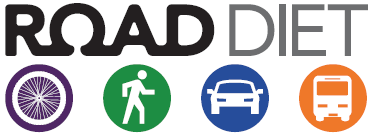U.S. Department of Transportation
Federal Highway Administration
1200 New Jersey Avenue, SE
Washington, DC 20590
202-366-4000


"A Road Diet costs our city tens of thousands of dollars versus a reconstruction project that costs millions."
Norm Steinman, Charlotte DOT
As roadway funding becomes more and more limited and improvement projects face fierce competition, public agencies search for cost-effective, practical solutions to meet safety and operational needs of all users. Road Diets are a low-cost countermeasure with proven safety benefits for both motorized and non-motorized users. A Road Diet reallocates roadway space to better meet current user needs. This configuration is an inherently low-cost solution, but agencies can reduce project costs even further by combining Road Diets with other programs, such as pavement overlays or restriping.
Expanding a street to include safety and multimodal improvements like bicycle lanes, a two-way left-turn lane (TWLTL), and wider shoulders is usually not a practical solution. Streets often exist in constrained urban or suburban settings, making the acquisition of additional right-of-way expensive and complex, if not outright impossible. Road Diets reallocate roadway space within the existing footprint, eliminating the need for purchasing property, lengthy environmental studies, complex design plans, and expensive construction. Moreover, Road Diets are one of the least expensive solutions for accommodating additional modes such as bicycles or transit vehicles.

All roadway crashes take a toll on society. Even minor crashes can require costly repairs, while the worst crashes can impact individuals financially for a lifetime. Additional societal costs include infrastructure repair, lost employee time at work, and insurance premium increases. In 2013, the U.S. Department of Transportation (USDOT) updated its estimated costs to society incurred by fatal, injury, and property damage only (PDO) crashes.1 Research has shown that the typical four-to three-lane Road Diet reduces the total number of crashes by 19 – 47 percent, resulting in significant cost savings.2
Road Diets can reduce overall maintenance costs, especially when they decrease the number of travel lanes. Alternative facilities such as TWLTLs, bicycle lanes, medians, and wider shoulders receive less wear than travel lanes, and therefore require less effort to maintain and repair. Additionally, agencies may experience some cost savings during winter months if there are fewer driving lanes to plow during snowstorms.
Although a stand-alone Road Diet is relatively inexpensive, agencies can reduce project expenses even further by coordinating the Road Diet with regularly scheduled resurfacing work. Within these projects, Road Diets add only a nominal expense to the overall project costs but provide a large benefit that ultimately achieves the project's end goal. The table below illustrates how coupling a Road Diet with a resurfacing project can reduce costs more than 50 percent compared to a stand-alone Road Diet. The example converts a 4-lane undivided 5000ft long roadway section into two travel lanes, a TWLTL, and two bicycle lanes.
| Item | Unit | Quantity | 2015 Estimated Unit Cost | Total Cost per Mile (No Resurfacing) | Total Cost per Mile (Full Resurfacing) | Comments |
|---|---|---|---|---|---|---|
| Lane Line Eradication | LF | 15,000 | $1,50 | $22,500 | $0 | No resurfacing: Assume three lines entire length. Resurfacing: Not necessary. |
| Bike Lane Lines Thermoplastic (6") | LF | 10,000 | $1.50 | $15,000 | $15,000 | Both: Assume two solid lines entire length. |
| Travel Lines Thermoplastic (4") | LF | 15,000 | $1.00 | $15,000 | $0 | No resurfacing: Assume two solid lines entire length and two striped lines at 50% coverage entire length. Resurfacing: Included within base project. |
| Bike Lane Thermoplastic Pavement Marking Symbol | EA | 40 | $300.00 | $12,000 | $12,000 | Both: Assume one symbol every 250ft each side of road (bike lane). |
| Bike Lane Sign | EA | 20 | $250.00 | $5,000 | $5,000 | Both: Assume one sign every 500ft. |
| Left-Turn Thermoplastic Pavement Marking Symbol | EA | 20 | $300.00 | $6,000 | $6,000 | Both: Assume one symbol every 250ft (Left-turn arrows). |
| Maintenance of Traffic (10%) | LS | 1.00 | $7,500 | $7,500 | $0 | Resurfacing: Included within base project. |
| Subtotal: | $83,000 | $38,000 | ||||
| 20% Contingency: | $17,000 | $8,000 | ||||
| Total Estimated Cost: | $100,000 | $46,000 | ||||
Road Diet projects are eligible for funding through Federal programs like the Surface Transportation Program (STP) and Highway Safety Improvement Program (HSIP), as well as other funding mechanisms. For example, Washington State DOT has used funding from such sources as pedestrian and bicycle programs and transit grants. Seattle Department of Transportation (SDOT) has used Safe Routes to School grants for Road Diet installations. SDOT also monitors the city's road resurfacing projects to see whether streets scheduled for upcoming roadway overlay projects are good candidates for Road Diets, allowing the agency to use annual paving program funds for some installations.3
To learn more about funding opportunities, contact your FHWA State Division office.
U.S Department of Transportation
Federal Highway Administration
FHWA-SA-16-100
1 U.S. Department of Transportation. Memorandum to Secretarial Officers and Modal Administrators from Polly Trottenberg, Under Secretary for Policy. February 28, 2013. Return to note 1.
2 Evaluation of Lane Reduction 'Road Diet' Measures on Crashes. FHWA Report No. FHWA-HRT-10-053. Washington, D.C. 2010. Return to note 2.
3 Road Diet Informational Guide. FHWA Report No. FHWA-SA-14-028. Washington, D.C. 2014. Return to note 3.
